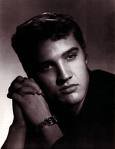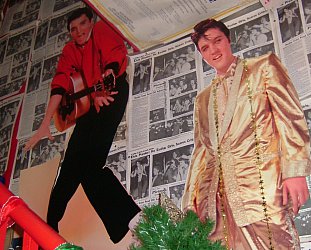Graham Reid | | 6 min read

This year, 1992, Elvis Presley - the first and only king of rock’n’roll - has been gone 15 years, yet, ironically, he often seems more alive than ever these days.
Living Colour may insist Elvis Is Dead and Public Enemy rightly rap, “Elvis was a hero to millions but he never meant shit to me.”
But that is now - and Elvis was then.
As Native American poet/singer John Trudell says on his latest album, Elvis “made us feel all right, we were the first generation of the postwar baby boom. The generation before had just come out of the Great Depression and World War Two...every culture has a song (and) their music was restrained emotion...Elvis showed every boy/man, girl/woman there was something good in feeling good...to be sensual is to be really okay. We danced, even if we didn’t know how.”
Elvis was a schism in popular culture, a break with a past gained in shades of grey conformity. Today it is difficult – possibly even impossible – to understand how great that cultural shift was. All we have now are caricatures and outlines...and in a way it was that which killed him.
“Elvis became what we made him,” wrote Charles Shaar Murray in an obituary in New Musical Express.” And once we turned him into a poster, transformed him into an effigy, became something new by sucking on his soul, he became a monster: first a young beautiful and awesome monster and finally a hideous, pitiful monster who inspired a mixture of pity and derision and – maybe – a shudder of mortality, a frisson of decay.
“Elvis Presley was a symbol, yeah. He was an icon, he was rock and roll incarnate, he was an idol, he was a hero. He gave the kids a look and a sound and an attitude; he gave us his identity and once he gave it to us he was left with nothing of his own except the useless trash accumulated by millionaires who have nothing but money which can buy nothing but objects.
“The man grew ugly, the legend grew tarnished, the god became a joke.”
And then the god was redeemed.
Death ennobled Elvis.
He will now be forever young (or forever fat, depending on the refinement of your cynicism). And he, like all gods, is with us at all times.
He became the ghost who walked in Jim Jarmusch’s Mystery Train and an episode of Cheers, Al Bundy sweated his likeness and he gave Dread Zeppelin and El-Vez (a Mexican supper club act) their reason to exist. He’s on stamps in St Vincent, posters in China and has had his songs covered by everyone from ZZ Top to Cowboy Junkies, the Residents, John Cale, John Lennon . . .
Elvis lives? He is risen – and colourised in the new video release of his classic black ‘n’ white movie Jailhouse Rock.
“It was only because he died that he could be turned into a marketable saint and Graceland turned into a theme park and put on the National Register of Historic Places,” says Greil Marcus, whose recent book Dead Elvis attempts to make sense of the legacy of a man once known for making music.
“And because he died it allowed hundreds of thousands of people to play with the whole idea of Elvis and make up new Elvises and let them loose in the land.”
And not just in America, either. This week in Sydney Susan Charlton has curated the Elvis Sightings exhibition at the Australian Centre for Photography. She rang a few artists, asked if they’d like to do something with the King and no one refused.
“Everyone, even if they didn’t like Elvis, can still say something about him. Well, if you’re lucky.
Elvis may be gone, but his estate lives on and these days dead Elvis is a lot wealthier than he was in life. Despite selling more records than any other entertainer, he left an estate worth a mere $9 million...before tax.
Today, under the shrewd guidance of the sometimes litigious Elvis Presley Enterprises Ltd, the estate grosses around $27 million ever year and Graceland draws 650,000 visitors annually. “I’ve reason to believe we all will be received in Graceland...”
But don’t leave home without it.
Trinkets and tea towels, masks and mirrors, Elvis Presley wine (the King didn’t drink, but if he did...), posters and paintings... the detritus of a career that began in music and became bigger than that. Licensing arrangements and corporate lawyers are more often spoken of than Elvis Presley the singer.
And over the years Elvis’ music has been poorly served by the company which has repackaged the songs in endless, shoddy collections tossed out in new covers to seduce loyalists or impulse buyer’s Half a billion records sold since he died.
“I’ll be honest with you,” said Randy Goodman, RCA senior vice-president of marketing recently. “We’ve not been known in the past couple of decades for the commitment we’ve given to this artist. We’ve cried wolf a lot of times on Elvis, but this package is different.”
It certainly is. Goodman was launching the sumptuous Elvis, the King of Rock’n’Roll: The Complete 50s Masters, a five-CD box of 140 tracks all scrupulously remastered digitally, packaged with a fat book of memorabilia and essays and a sheet of Elvis album cover stamps. The set weighs a kilogram, contains every master studio take Elvis recorded in the 50s plus several alternate takes, live tracks, previously unreleased material and rarities such as My Happiness, a 1953 acetate recording Presley made in the Memphis Recording Studios.
At a time when Presley is caricatured, parodied, impersonated and reduced to a cartoon, any emphasis back on his music is welcomed.
The box, as Newsweek writer John Leland says, paints “an America in which nothing was certain; not the relationship between the races or classes not romance or finance, not the role or shape of music itself.”
What these recordings serve to remind us of is that Elvis – like the Beatles, the Stones, James Brown, Bob Marley, Bruce Springsteen and other crucial figures in rock history – was an instinctive synthesiser of styles.
Take just the first four songs Presley recorded for Sun over two days in June ’54: That’s All Right was an old blues written by Arthur “Big Boy” Crudup, I Love You Because is a sentimental country ballad, Harbour Lights was a Bing Crosby song and Blue Moon of Kentucky a bluegrass song by Bill Monroe. From those crosscurrents, and rockabilly, Elvis created his own music.
Naturally this massive, historical collection offers up ignored or little known masterpieces-in-miniature. The way his voice emerges from the double-tracking on Tomorrow Night to reach into your chest, the slapback rockabilly liberation of I Don’t Care If the Sun Don’t Shine and You’re a Heartbreaker, how he defined a whole 50s vocal style in Trying to Get to You...
And those gems are all on the first 30-track CD which also includes Heartbreak Hotel, Blue Suede Shoes, Mystery Train, those first four recordings and My Happiness.
The second disc – Elvis in early ’56 and now signed to RCA – kicks off in spectacular fashion: Lawdy Miss Clawdy, then Shake Rattle and Roll, an anguished I Want You, I Need You, I Love You and the classics Hound Dog and Don’t Be Cruel follow on from each other before the set moves into the Love Me Tender soundtrack where Presley brought out his own hillbilly voice.
Only the most dedicated of fans will fully embrace some of the Christmas songs from ’57 (although they illustrate the effortless breadth of Elvis’ range) but the set at least has the advantage of being complete for their inclusion. A great and errant collection by an artist, who will forever define rock’n’roll.
Project co-ordinator Don Wardell – who expects this 50s box will be followed by 60s and 70s sets, with the target date for completion in December ’96 – says these recordings provide “the definitive source” for anyone wanting to discover Elvis’ work.
That’s undeniable, but the compilation does have one irritating feature. Unlike most other retrospectives, this one isn’t chronological and sidetracks off on to the final Rare and Rockin’ disc the alternative takes two versions of Lovin’ You (slow and uptempo), and fascinating oddities. It seems a curious decision to put, for example, My Happiness on the first disc and its flipside, That’s When Your Heartaches Begin (which Elvis revisited more seriously in ’57) on the rarities disc.
That quibble aside, these recordings (which include a previously unreleased but dull 12-minute interview closing the fourth disc) put the music back under the spotlight and, stripped clean of the flotsam of personality and myth, it is engrossing.
The Che Guevara of baby boomers, as poet/singer John Trudell calls him.
But these were Elvis’ most consistent years. John Lennon always said Elvis died when he went into the Army (at the end of the 50s) and maybe that’s true. While Hollywood embalmed him, loyal fans sentimentalised and sanitised him. He was gone.
Like some leatherclad Lazaus, he rose again briefly in ’68 for a TV special, and a flurry of recording in Memphis in ’69 produced some of his finest work in a decade (Suspicious Minds, Long Black Limousine, In the Ghetto and Kentucky Rain among the 23 tracks cut in about 16 nights of hectic recording).
“Elvis was assassinated by fame,” sings Trudell, “it took him a long time to die and others seized control while Elvis rode the needle out and never understood what he had done.”
But when Elvis was in control, as he was in the years this commemorative box celebrates, he changed the world. Don’t step on my blue suede shoes was a warning that a new generation was coming through – one with money, style, attitude and a will to leave the past behind.
Few of us can know how that felt, what freedoms there must have been when those words came like a call to arms from afar.
That magic can’t work again, but it would be a sick heart that couldn’t hear something liberating in those now legendary words, “Willitza won furtha money...”







post a comment